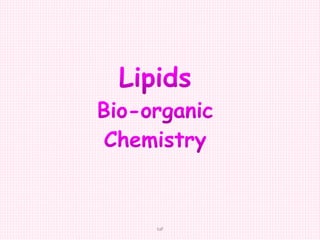Lipids are organic compounds composed mainly of fatty acids and glycerols. They are insoluble in water but soluble in organic solvents due to nonpolar hydrocarbon portions. Lipids serve important functions like energy storage, cell membrane structure, insulation, and as precursors to hormones. They can be classified as simple lipids like triglycerides or complex lipids containing additional groups like phospholipids and sphingolipids. Common reactions include esterification, hydrolysis, hydrogenation and oxidation. Lipids are essential for various biological processes.















































